Teams with a defensive identity succeed far more than a side who does not employ well thought out tactics to win the ball back and prevent a goal from being scored.
Defending is an often difficult area of the match that teams will not train as much because in order to win, you have to score.
While in the context of the game we tend to associate tactics to offensive styles of play, teams with a defensive identity tend to succeed far more often than a side who does not.
There is no surprise that the clubs at the top of their respective leagues are consistently within the top five clubs in terms of goals conceded.
The reason they are elite is because of the complete identity, both defensively and attacking.
For example, Liverpool have the least goals conceded with 21 in the Premier League after 31 matches played.
Real Madrid have an identical defensive record of 21 goals conceded in La Liga, and Juventus have the best defence in the Serie A.
These three examples from Europe’s top leagues show just how important defending is to a clubs identity.
In order to separate different identities, there are many different types of defensive blocks and philosophies a manager can employ.
These philosophies include counterpressing, high pressing, pressing traps, zonal marking, etc.
While we could spend days talking about niche tactics in the analysis, this tactical theory piece will focus on three areas of the pitch where a defensive unit is stationed.
This tactical theory and tactical analysis piece will examine the advantages and disadvantages of the high, standard and low block as well as how different teams in Europe employ these tactics.
What Is High Block In Football?
The high block, more commonly referred to as the high press or high line, is where a team will put immense pressure on the opposing ball carrier, making the field very compact.
This tactic is typically seen in teams that are on the front foot and use the advantages of this system to launch their attacks in transition quickly.
A key feature of the high block is coordinated movement (this claim is true for all successful defences, but the high press requires more movement than other systems).
This requires players to be very disciplined and most of all fit.
The high block is a very “high risk, high reward” tactical system.
Below is an example of a typical high block in a 4-3-3 formation.
The 4-3-3 is a typical formation when implementing the high press due to the ability to cover the opponents back line with three forward players.
In this diagram, it features a scenario where the red circle is the opposing player with the ball.
The blue team is set up in a 4-3-3 formation when the press initiates.
The arrows show the forwards and midfielders moving toward the ball to close down the space.
The striker will make sure to press the ball carrier so that he can not pass to the other centre-back.
The space that is affected during the high press is highlighted in the green zone.
This is the area of the pitch that the defending team hopes to control and trap the team in possession.
An effective high press will force an error that will likely come in this zone.
The yellow zone represents the area of the pitch that the defending team is willing to give up during the high press.
Because the player in possession will have to get rid of the ball quickly, it is likely he could pass the ball forward into the yellow zone.
The defending teams midfield will push forward which will create space behind them, allowing the attacking team into that area.
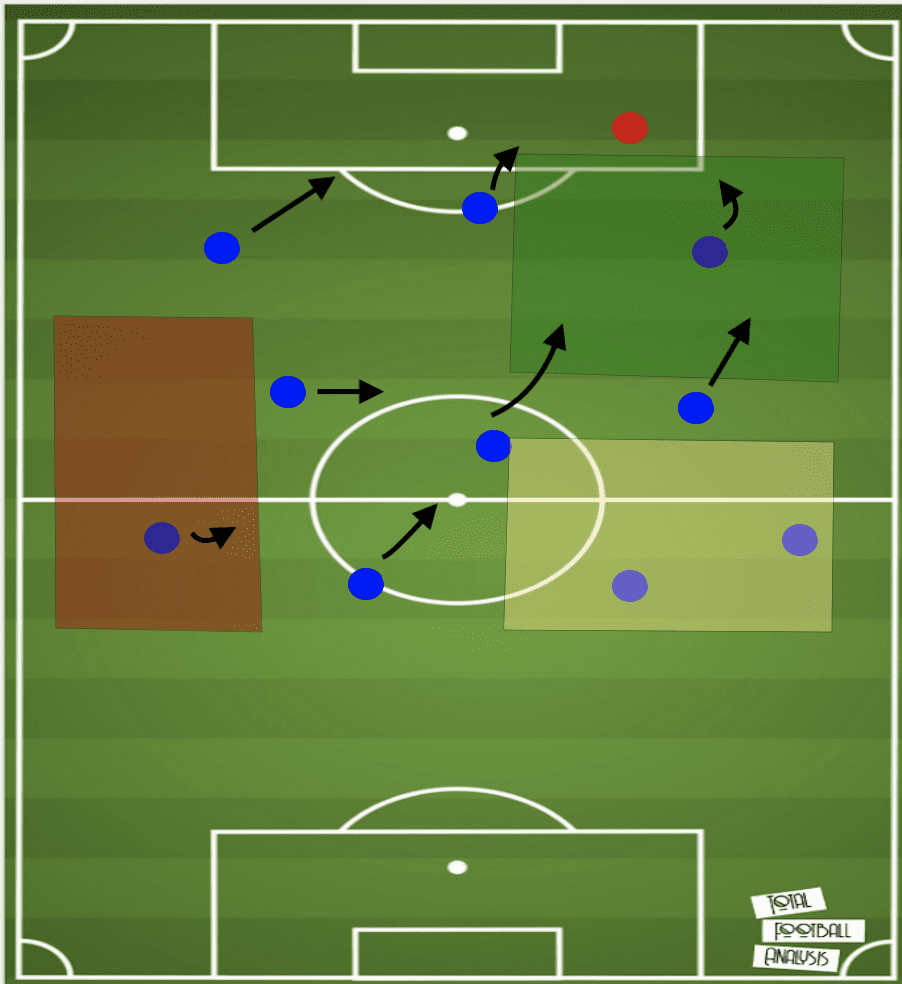
When a team presses, they are doing so knowing that other spaces will open.
This is typically planned – it is called a pressing trap.
Pressing traps are a common addition to high pressing tactics.
The red zone refers to the area of the pitch that is a danger zone due to the high block.
Because the entire team shifts over, it leaves a lot of space on the other flank.
It is important to not allow a big switch of play to happen.
Typically, because a high press intends on closing down the ball carrier quickly, this does not occur.
However, it is a big risk.
It is usually advised to not utilise a high block against a team whose defenders have the ability to hit accurate long balls that can create a switch of play.
A great example of this is Liverpool.
If a team presses Liverpool, the likes of Virgil Van Dijk, Trent Alexander-Arnold and Andrew Robertson will bypass the high block with a long ball.
On the other hand, a team like Manchester United may be more susceptible to the high block because Aaron Wan-Bissaka and Luke Shaw are not as gifted at delivering accurate long balls.
Advantages & disadvantages of the high block
The advantages of a high line lies in the distances between the defending side and the opposing team in possession.
Little space creates a much more compact playing area, making it easier to close down the opposition who are trying to find passing lanes.
If the defending players do win the ball back as designed, their positioning will lead to another advantage.
When they win the ball, they are in a position to quickly recycle the ball to the forward line.
Again, there is less space to cover.
Theoretically, passes will be easier due to the distance between them.
If the team who just won the ball finds themselves pressured by a counter-press, they can quickly drop the ball back to the centre-backs.
This will start the next attacking phase.
Disadvantages of this defensive block can occur quickly.
As stated earlier, this is a high risk, high reward system.
If the defending team has a lapse in their defensive line, they can find themselves exposed.
Because the line is high, opposing forwards can get in behind the defenders.
If an opposing team has extremely quick wingers or midfielders who are exceptionally talented at playing the long ball, this tactical system can be dangerous.
Furthermore, the high block requires a lot of energy.
If the team employing the high block does not implement high pressure, they are wasting valuable field position.
This is why you may not see the high block being employed the whole match, but in certain situations and periods of the game.
High Block Team Example – Ajax
An example of an effective high block occurs in the analysis below.
Ajax are a team that enjoys pressing the opposing team while staying in their 4-3-3 formation.
They rank highest in the Eredivisie with a PPDA of 7.33.
This means that the average number of passes the opposing team makes per action is 7.33.
Ajax are far better than AZ Alkmaar who rank second with 10.67 passes.
These statistics prove just how effective Ajax are when applying pressure.
Referring back to the earlier diagram, we encounter a similar scenario below, just flipped to the other side of the pitch.
Here, Valencia’s centre-back is on the ball and looks to pass the ball laterally to his centre-back partner.
This action triggers the high block into a high press for Ajax.
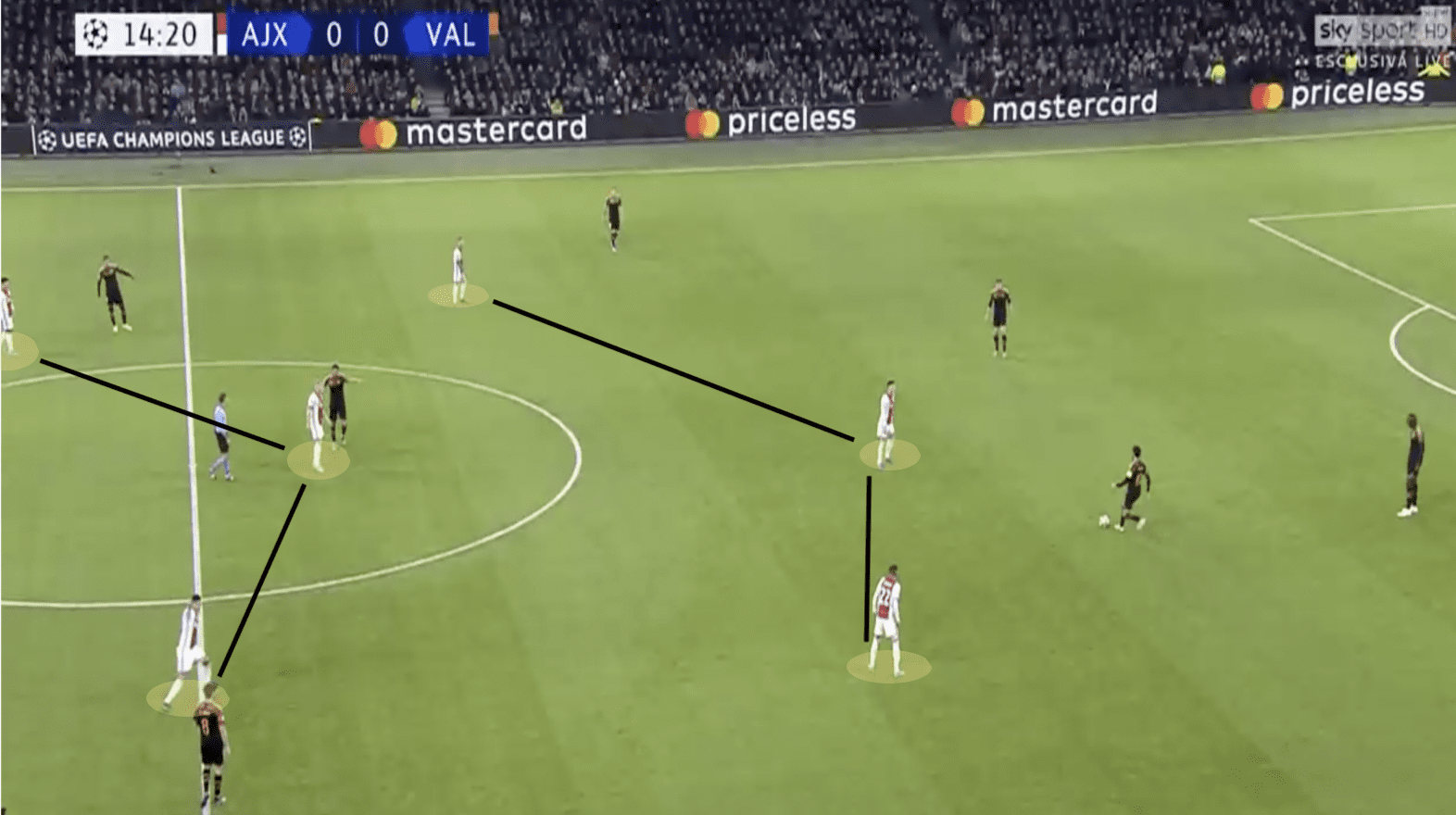
Once the ball is switched, the front three and midfield two of Ajax immediately begin to shift over together.
Notice that each forward is marking the defenders while the midfielders are shifting over to ensure Valencia are trapped on the right side of the pitch.
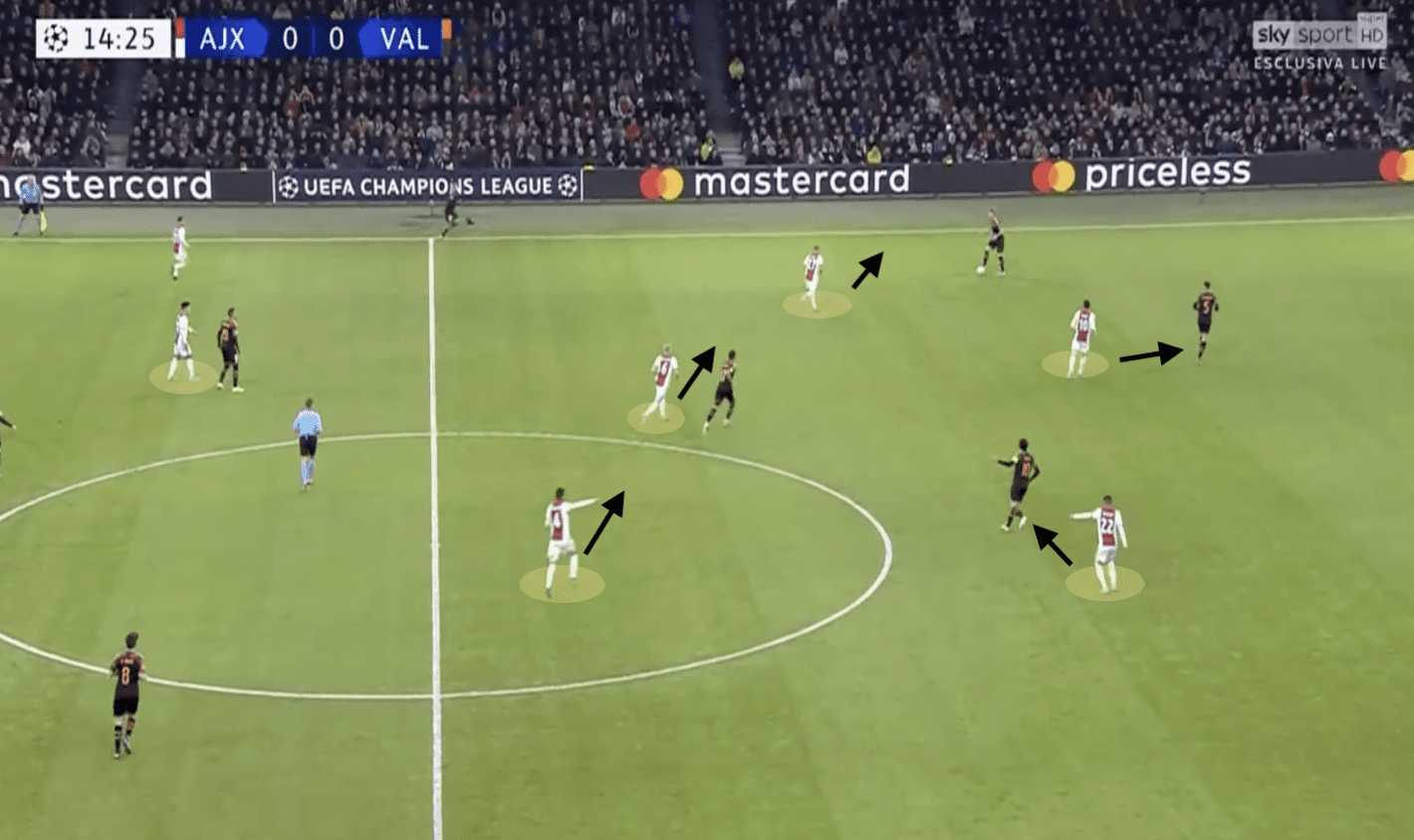
As the press is in effect, the space highlighted below opens up.
This space is expected to be open and that is the way it was designed.
The right back of Valencia only has one clear passing option, a pass into the space that Ajax wants him to play the ball.
From here, Ajax can win the duel where the Valencia forward has limited options.
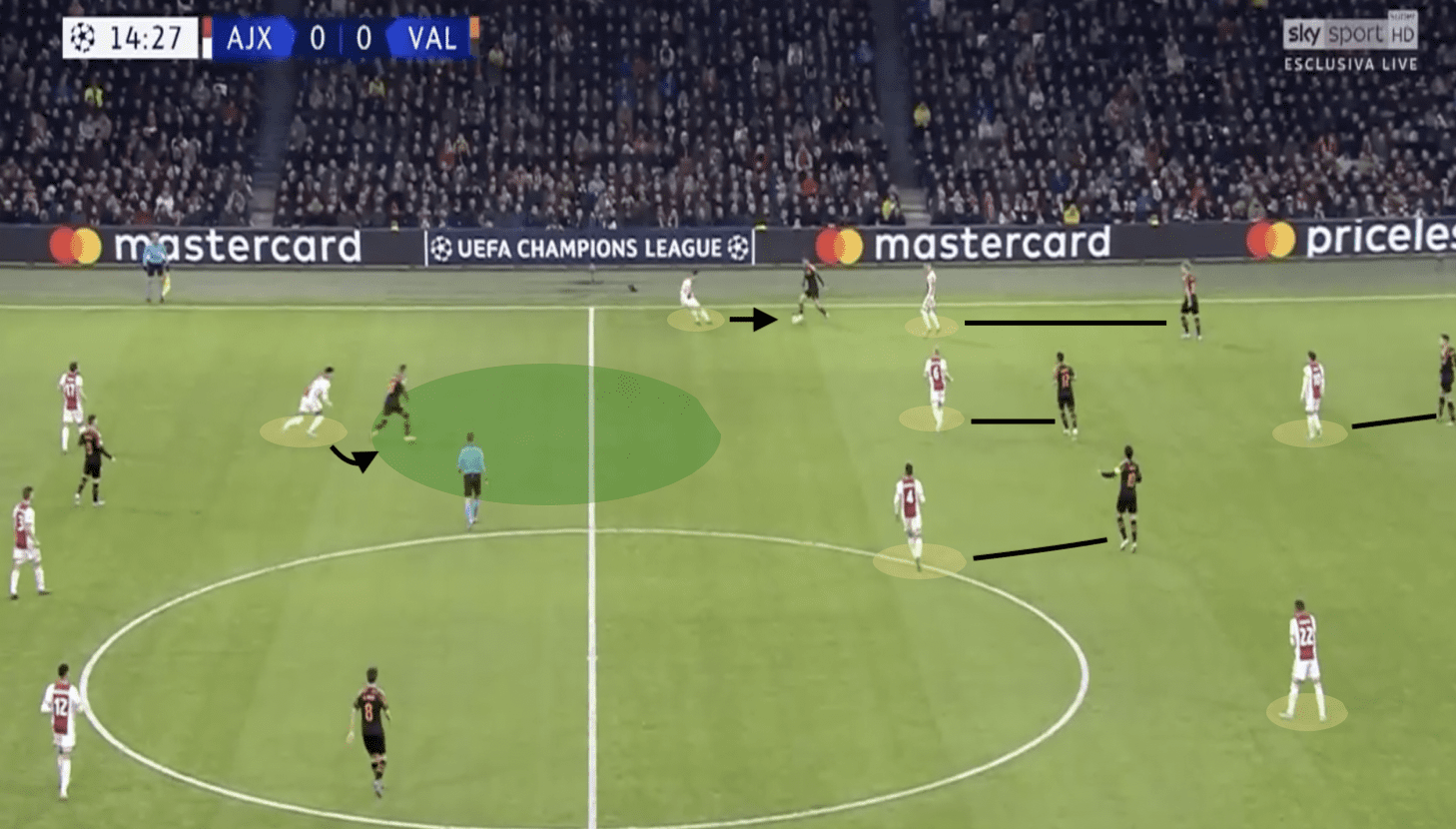
Player Profile of a high block in a 4-3-3
ST – The striker in this formation can be many different kinds of players.
However, for a high block system which focuses on pressing, it is important to have a player who is incredibly energetic and dynamic in their movements.
This player will be asked to do a lot of closing down on the ball and will need to be able to attack with good forward runs if they win the ball.
Typically, a player who is technically gifted will excel in this role that requires working while fatigued.
RW/LW – Right and left wingers in this formation are usually extremely gifted players and are the team’s main attacking weapons.
Attributes include tremendous pace and skill.
These players may not be the best defensively but they will have good awareness in terms of positioning.
Rarely will they constantly be engaging in tackles, yet their defensive positioning will lead to problems for the opposition.
LCM/CM/RCM – The midfield in the 4-3-3 can be very dynamic and it is up to the manager how they want to create and defend.
For a 4-3-3 that is focused on playing a high block and keeping high defensive pressure, (not all 4-3-3’s are like this but it is the case for this tactical theory piece) it is important to have three energetic midfielders that are extremely aware of their positioning.
The high press starts with the forwards but can break down if the midfield does not understand their positions.
Typically, the centre of the midfield three will be more of a defensive midfielder by trade who is capable of playing key passes from deep.
On either side of the centre, it is up to the manager whether they want to focus on defensive or attacking qualities in these players.
The key is finding the right players who keep balance while also understanding their positions.
LB/RB – The right and left backs in this formation tend to be able to support the wings well.
Because of the high block, it is unlikely that they will have to face many one-on-ones or defensive duels.
They will push high up the pitch to be direct support for the wingers because the midfield three is more narrow in the centre of the pitch.
The most important attribute defensively is the awareness of the wingbacks.
As explained in the diagram, when the high block is implemented with the press, the opposite wing is left exposed and is dangerous (the red zone in diagram).
It is important that the left or right back does not get caught too far inwards when the team shifts.
LCB/RCB – The centre-backs in this formation and tactics need to be good at reading the field of play and communicating to the team.
The centre-back sees everything in front of him and can trigger the high press.
It is also important for the centre-backs to control the offside line.
The defensive team can not afford to commit too far forward or there will be a lot of space in behind.
Exceptional pace is an added bonus if a ball gets in behind the back line.
What Is Standard Block In Football?
The second defensive block in this tactical theory piece is the standard block.
Do not be fooled by its simplistic implications, as the standard block can become incredibly complex.
In an effective standard block, if one player is to lose shape, it affects the whole ecosystem of the defending side.
The reason this defensive system is known as the standard block is due to its positioning on the pitch.
The defensive unit is in a more standard area with the forwards hovering just above the half way line, and the defenders keeping a comfortable distance between them and their goal.
Many managers or coaches who do not focus on defending in their tactics would consider this a basic principle.
While that may be true, again, this should not be considered a basic system.
When effective, it can devastate even the world’s most ruthless attacks.
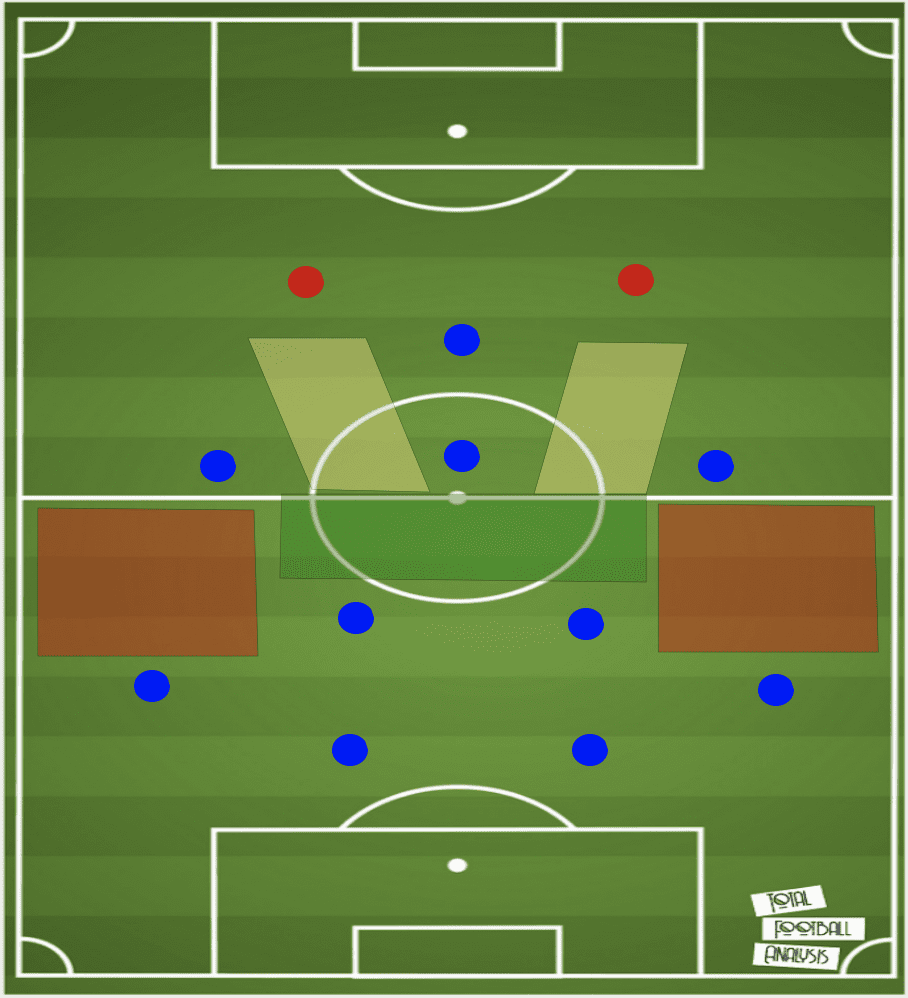
The diagram above explains how the standard block can be effective and where it can be dangerous in terms of spacing on the pitch.
The team is set up in a balanced 4-2-3-1 formation and the red circles represent the opposing centre-backs, one of which has the ball.
When in the standard block, it is likely that the manager is comfortable with giving the opposition time and space while the defenders are in possession.
The yellow zones represent the area of the pitch that the defending team are willingly giving up.
These are passing lanes that are inviting for the opposing centre backs to play into.
The reason they give up the passing lanes is because the two defensive midfielders are stationed at the end to apply pressure.
The green zone is the area of the pitch that is under great control from this defensive set up.
The two lines of midfielders create a pentagon shape which will make playing through the middle of the pitch incredibly difficult for the attacking team.
While there is more control over the centre of the pitch, it is likely that the wings will be an area of danger for the defence (marked with a red zone).
The reason for this is because it is common for the LAM and RAM to get caught too far up the pitch due to their more attacking nature.
Likely in a match this formation will switch to a 4-3-3 while in a transition.
Advantages & disadvantages of standard block
Advantages of the standard block are that it is an extremely compact and balanced defensive tactic.
As stated earlier, the team is not too far forward or back, which leads to a nice balance that will allow the team to seamlessly work attacking transitions.
It can be easier to keep in shape because this system does not require as much energy as a team who presses high up the pitch.
Furthermore, when transitioning to an attacking phase, it is easier to keep possession of the ball because of the numerical advantage in the midfield area.
Disadvantages of this system can be that there is not as much pressure on the ball carrier of the opposing teams.
In most instances, a side that employs this tactic will be inviting the opposing team to take them on and try to break down the unit (which could be an advantage too).
However, the major disadvantage to this system is that if one player loses the shape, it will affect the whole unit.
While this is true for any defensive system, the standard block has less pressure on the ball and still does allow some space in behind.
Therefore, it is incredibly important to stay compact.
Standard Block Team example – Bayern Munich
An example of the 4-2-3-1 standard block taking shape occurred when Bayern Munich played Chelsea in the first leg of the UEFA Champions League Round of 16.
The image below shows the two pivot players in behind the attacking midfield three creating a very controlled area.
As the Chelsea centre-backs look for passing options, the passing lanes are open but there are no Chelsea players present.
This is because Bayern Munich have so much control of their defensive shape.
Similarly to Ajax, Bayern Munich have a PPDA of 7.54, showing their dominance defensively.
In this scenario, Antonio Rudiger really only has a passing option to Marcos Alonso on the wing, an area that is a danger zone but is less threatening than giving up space in the middle of the pitch.
These tactics work well for Bayern as they can control the midfield space.
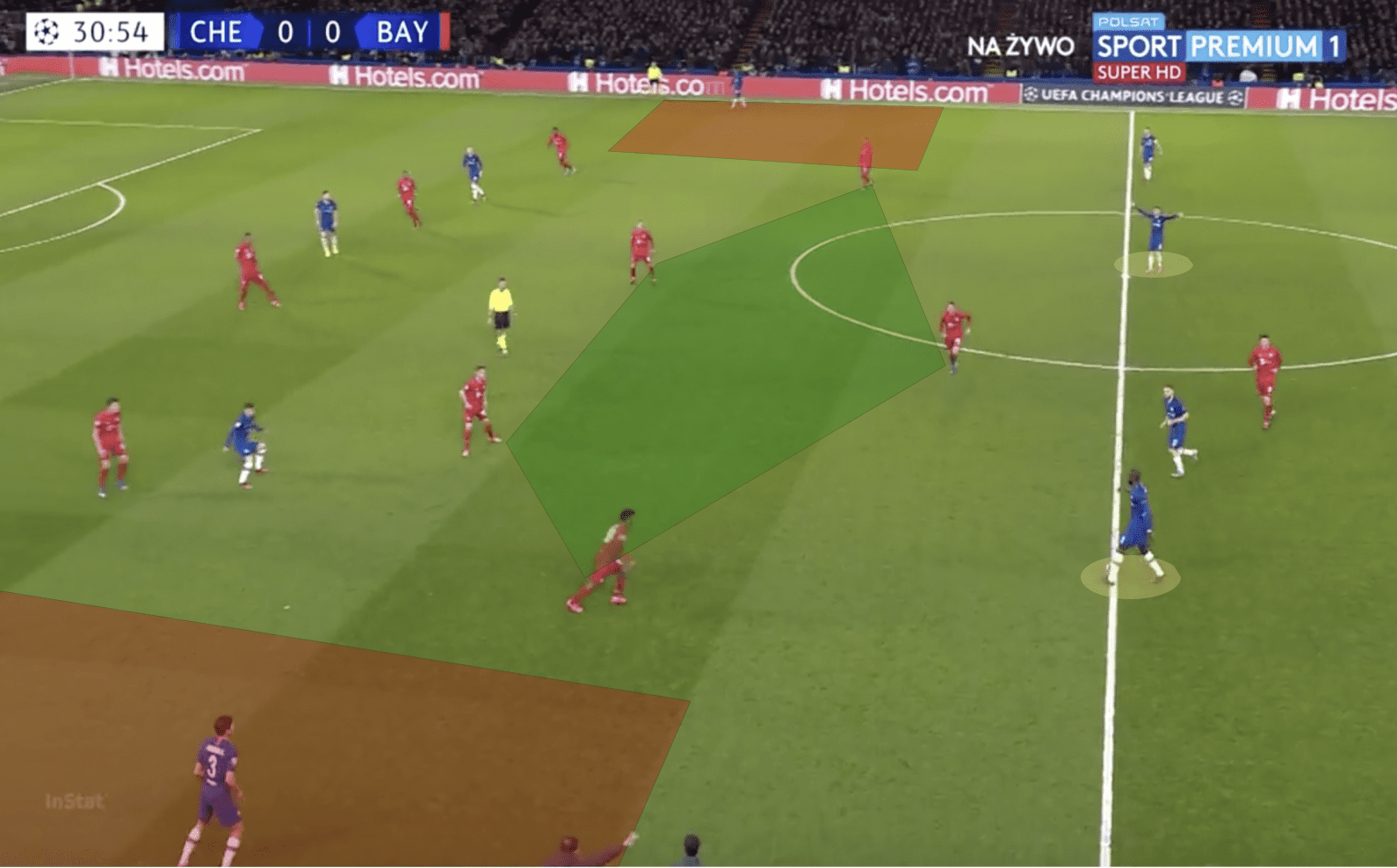
Player Profile of a standard block in a 4-2-3-1
ST – The striker in this formation is typically a true number 9 and natural goal scorer.
It is less important to have a striker who is very creative.
This player needs to be able to put the ball in the back of the net.
Typically, managers will prefer this player to be stronger and be capable of being dynamic while in attack.
Defensively, there is not much the number 9 will need to do in the standard block except shadow defenders to force them to one side of the pitch.
LAM/RAM – These players are typically not as strong defensively but need to be aware of their role as outside midfielders when the opposing team is attacking.
If they are caught too far forward, it will leave the defensive midfielders exposed.
A good work rate is a key attribute of an effective outside midfielder.
CAM – This position is the heartbeat of the team.
They are responsible for being the main creative spark.
In regards to the defensive side of the ball, it is likely that in a standard block, the CAM will be tasked with putting pressure on the defensive midfielder who gains possession inside the defending team’s half, preventing key passes from being played from deep.
LDM/RDM – It is incredibly important for these players to be extremely strong in tackles and positional awareness while playing defensive midfield.
If they get caught out the advantage of the 4-2-3-1 becomes null.
These pivot players will have to be good ball carriers and have a large passing range when the ball is turned over in an attacking transition.
LB/RB – The left and right backs in this formation tend to be balanced.
It is important for them to be able to decide when is the right time to engage the wingers who have possession out wide.
As identified in the diagram, the danger zones are on the wings when defending in the 4-2-3-1 standard block, so it is important for the outside backs to not be out of position.
LCB/RCB – Centre-backs need to be strong in the air as lots of crosses will come into the box from wide areas.
Attributes such as communication and vision while defending are incredibly important for the centre-back.
Specifically, communicating with the two defensive midfielders will be important.
What Is Low Block In Football?
The final defensive block that will be covered in this tactical theory piece will be the low block.
The low block is perhaps the least desirable tactic for viewers and managers.
Typically, the clubs with less quality will employ the low block system.
However, there are moments in every match where, even for the teams with high quality, will set up in the low block.
This tactical system occurs when the defending team is pushed right back against their own goal.
Each player is in their own half and the opposing team has the ball well inside the half they are attacking.
This creates an onslaught of attacking sequences and a difficult time managing the match for the defending side.
Even if they win back possession of the ball, they do not have much space to escape the low block they established.
Teams who are closer to their own goal are more likely to concede.
This is a fairly simple concept: as the attacking team gets closer to the goal, they are more likely to score.
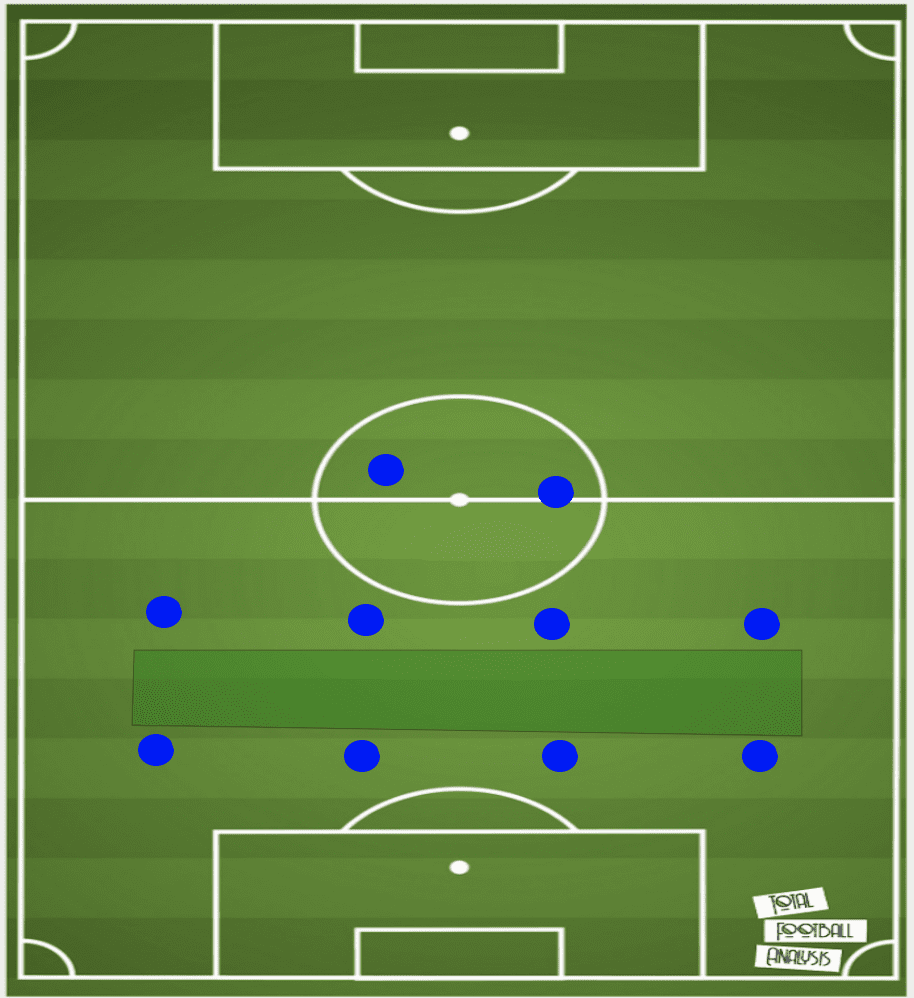
Advantages & disadvantages of low block
There are a couple of advantages of the low block, but more often, the disadvantages prevail.
When in the low block, it can make it incredibly difficult for the opposing team to break you down.
Sometimes the attackers are lacking creativity and struggle with the lack of space given to them.
As seen in the diagram above, one of the key areas that the low block controls is the half space between the defensive and midfield line.
Another advantage is the moment where the defending team can launch a counter attack.
The attacking team will sometimes push so many resources forward that they get caught out trying to score a goal.
Moments like these can completely change the tides of a match.
Despite these advantages, the disadvantages outweigh them.
The low block is associated with last ditch defending which can lead to immense pressure on your own goal.
Without an outstanding keeper performance, the defending teams tactics may go to waste.
Low Block Team Example – Atlético Madrid
The analysis below will show an example of an effective low block in a 4-4-2 formation.
While Atlético are not deeper in this particular example, the concept and principles of this shape and play transcends anywhere while in their own half.
What makes Madrid so effective is their attention to detail.
Diego Simeone is a mastermind when it comes to defensive tactics and is very demanding of his team.
Both the defensive and midfield line are in a perfect parallel shape, both horizontally and vertically.
This creates the half-space between them.
The reason they can control the half space is because even when the attacker is furthest away from either a defender or midfielder, both players are an equal amount of distance away from the attacker.
This allows either the defender or midfielder to close down the attacker quickly and effectively.
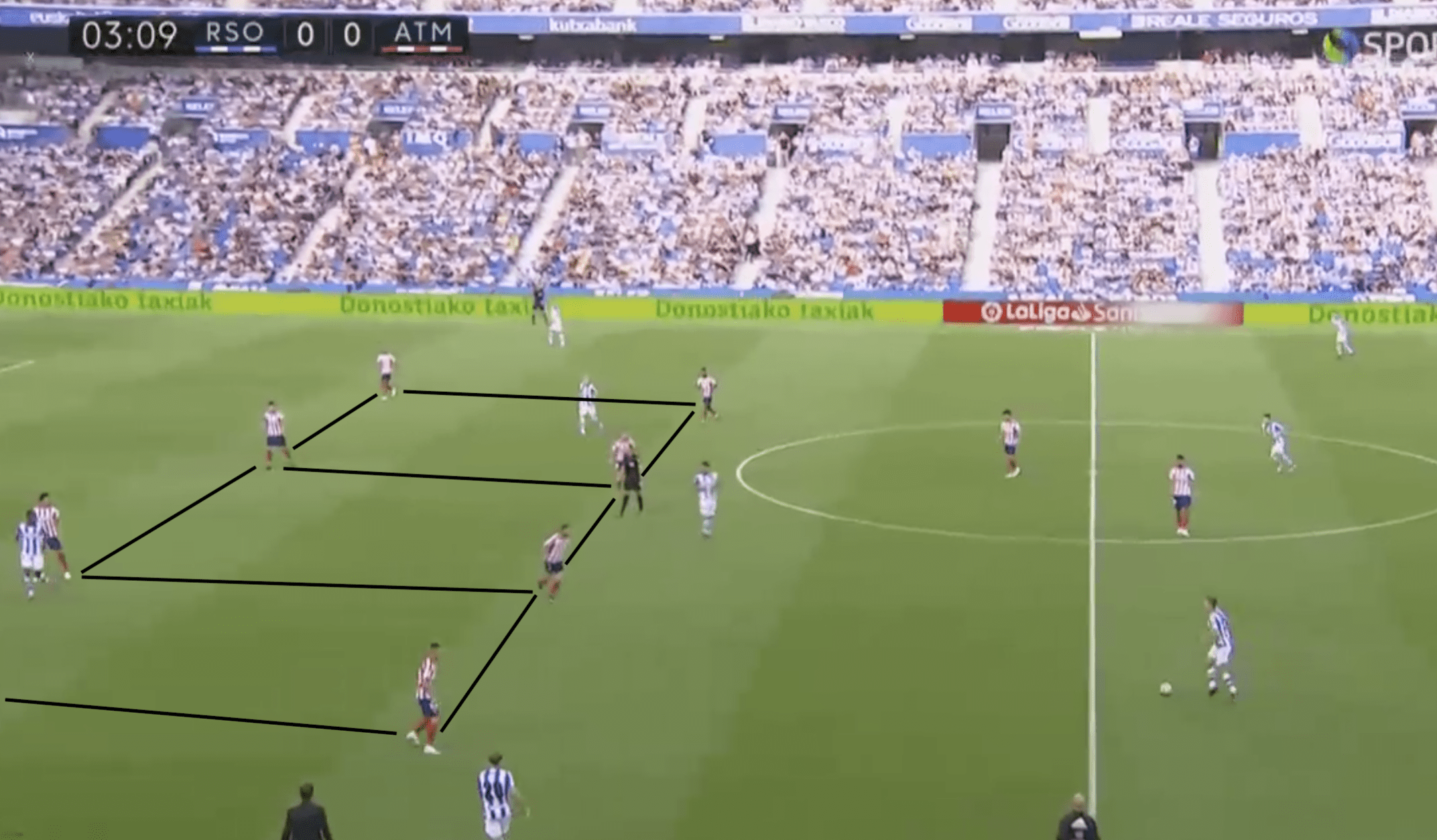
An example of this takes shape as the Real Sociedad midfielder plays the ball into feet of the attacker.
The attacker is trying to occupy the half space but Atlético Madrid’s shape is so tight-knit that it is completely under control.
The defenders and midfielders converge on the ball forcing the forward into a bad pass.
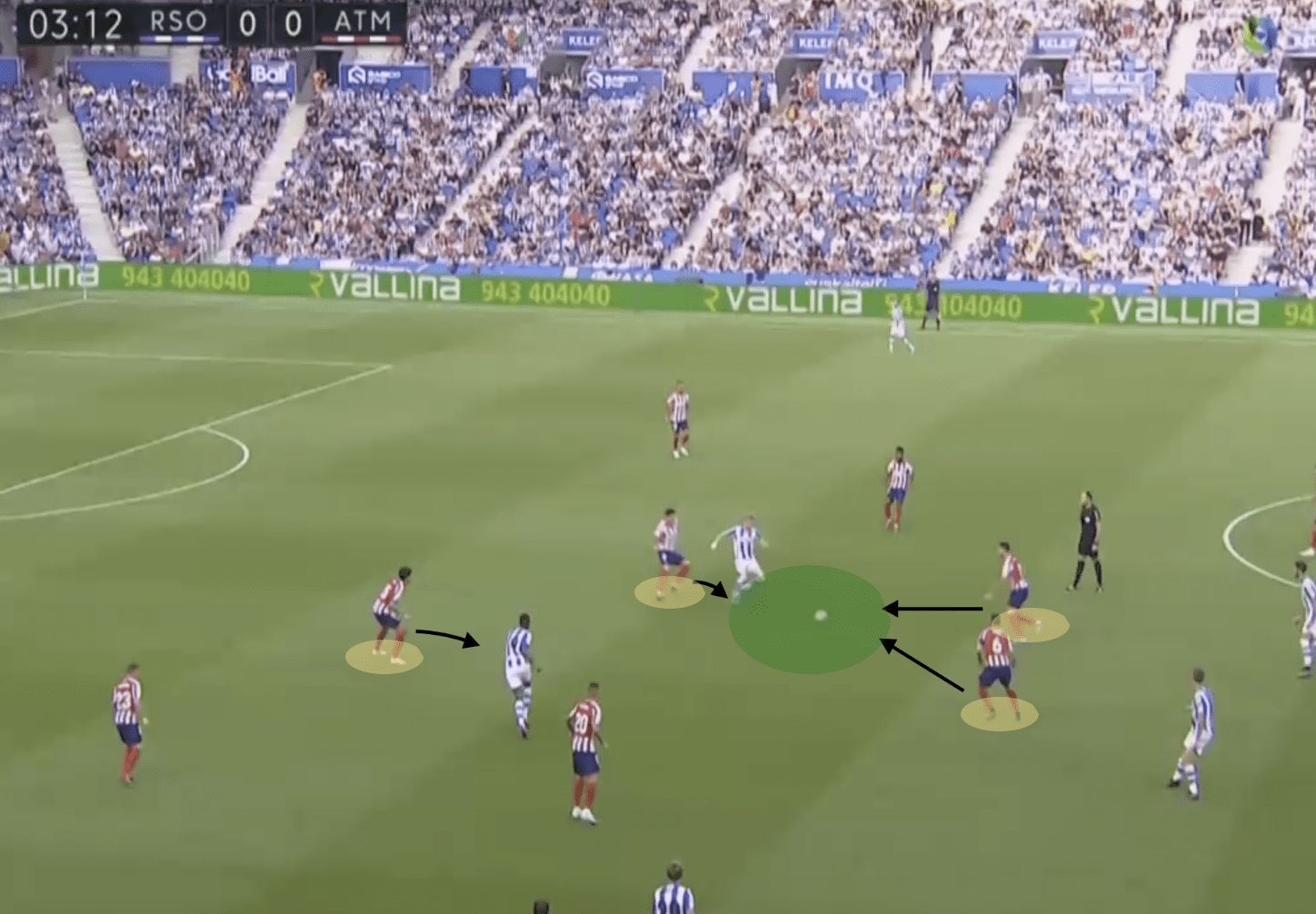
Even after the bad pass when Kieran Trippier regains possession of the ball, Madrid are already back into their shape.
This is a testament to the level of detail that Atlético exude during their style of play.
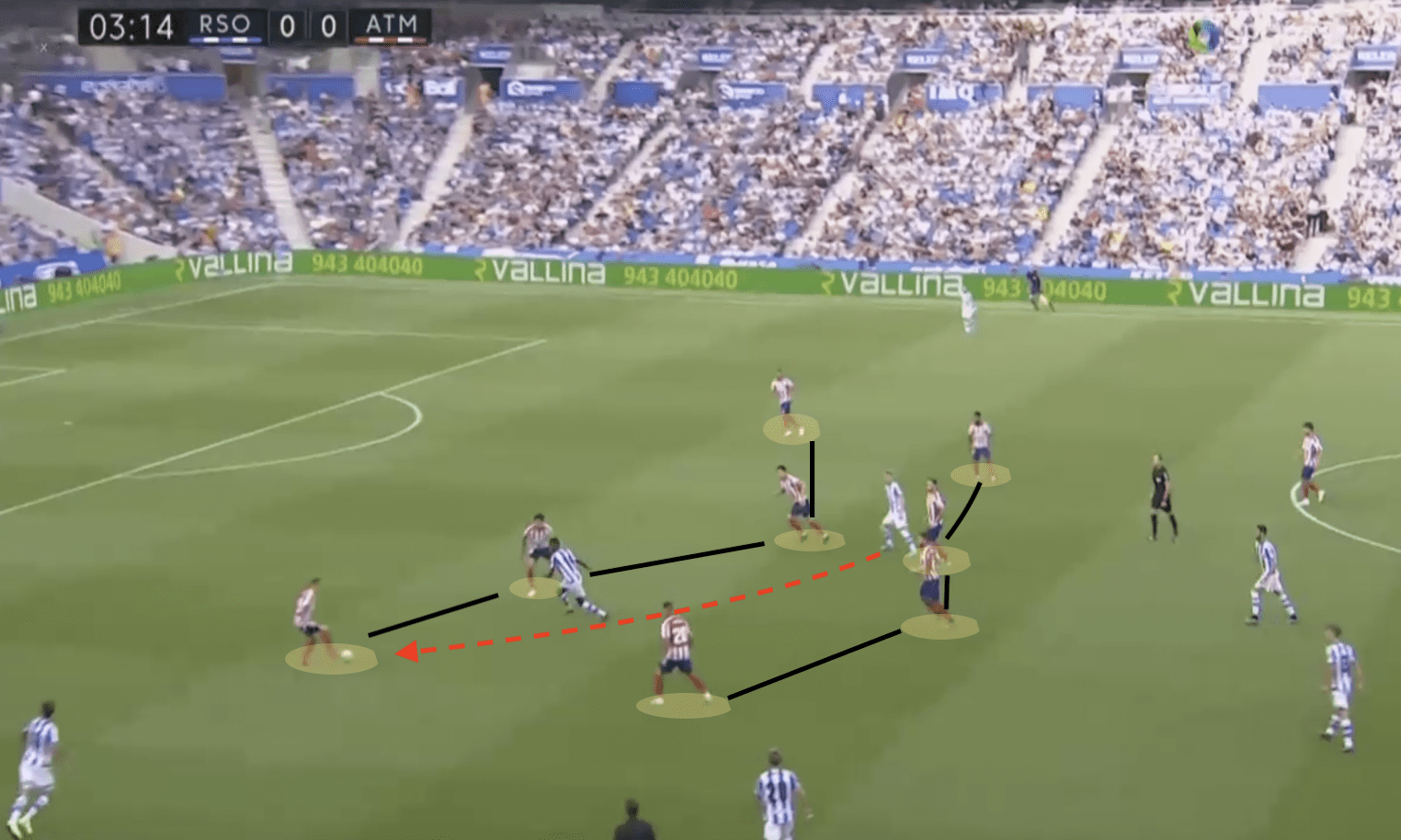
Player Profiles while implementing a low block in the 4-4-2
LS/RS: One striker needs to be capable of holding up the ball.
The reason for this is because when the team is in an attacking transition, players need time to advance up the pitch to leave the low block.
A striker that has physical and technical ability to hold up the ball while withstanding pressure is crucial in this system.
Typically, this player will have strong aerial ability but does not always have to be a presence in the air.
The other striker can also be capable at holding up the ball but can be more dynamic.
A player who couples a physical striker tends to be more technically gifted and agile.
This is because as one striker is holding up the ball, he can play a pass to his striking partner.
Therefore, if the other striker has creativity and close control ability, it will lead to a more dynamic attacking sequence.
RCM/LCM: These midfielders have to be capable on both sides of the ball, meaning their attacking creativity and defensive urgency require a sense of harmony.
This is difficult for managers who like to deploy a creative midfielder.
However, in a low block tactical setup, the second striker who is more technically gifted can act as this creative player.
It is likely that in a low block, the team will have less possession inherently, therefore eliminating a need for a creative spark to gain an advantage.
Because they will experience less possession, it is crucial that the central midfield players have great positional awareness.
This will lead to proper spacing and the chance for interceptions in the middle of the pitch.
RM/LM: Similarly to the centre of the pitch, these outside midfielders need to be capable defensively.
It is important that they do not let players in behind if they get caught too far up the pitch.
Due to the low block being so deep, the primary objective of a RM/LM is to prevent early crosses from coming into the box.
Since the defending team implementing the low block is so deep, early crosses are a way an attacking team can penetrate the box without getting too close to the goal.
On the other hand, these outside midfielders possessing a lot of pace is important while on the counter-attack.
LB/RB: The right and left backs in this tactical setup need to be very capable in one-on-one situations.
Because the defence is compact, the areas of the wing may open up after a switch of play by the attacking team.
This is where the outside-backs will become isolated in a defensive duel.
Winning these duels will prevent the attacking team from entering the box and penetrating the block.
While attacking characteristics such as crossing is a helpful attribute to have, it is not necessary when implementing the low block.
Rarely will a team who is implementing a true low block need wingbacks who make constant overlapping runs to join the attack.
LCB/RCB: These defenders need to have traits such as aerial ability, leadership, and good reading of the game.
Because the centre-backs can see the whole pitch in front of them, they are the last line of defence.
Another point of emphasis is aerial ability – the defending team will likely control the middle of the pitch much better due to numbers and spacing.
Therefore, attacking teams will likely put crosses into the box on a much higher rate.
Winning headers is incredibly important for any central defender, but it is even more important when defending the low block.
Finally, it is crucial that these centre-backs are gifted tacklers of the ball.
Conclusion
This tactical theory analysis explained the three defensive blocks: the high, standard and low block.
Each defensive system has its pros and cons and the decision on what system to play should be determined by the players you have at your disposal and the space you want to give up.
You have to ask yourself: do my players fit the player profiles of these tactics? If you try to create an identity which isn’t true to yourself and your players, it will be difficult to be successful.
It is likely if you examine top teams in the world of football, their defensive shapes will match the players they have in the squad.
Finally, put as much emphasis on your defensive tactics as you do attacking tactics to create a full identity for your team.





Comments